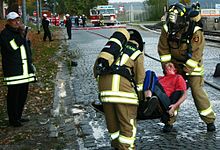United States

See Emergency Medical Responder
Historyedit
The U.S. Department of Transportation (D.O.T.) recognized a gap between the typical eight hours training required for providing advanced first aid (as taught by the Red Cross) and the 180 hours typical of an EMT-Basic program. Also, some rural communities could not afford the comprehensive training and highly experienced instructors required for a full EMT-Basic course. The First Responder training program began in 1979 as an outgrowth of the "Crash Injury Management" course.
In 1995 the D.O.T. issued a manual for an intermediate level of training called "First Responder." This training can be completed in twenty-four to sixty hours. Importantly, this training can be conducted by an EMT-Basic with some field experience—which is a resource available "in-house" for many volunteer fire departments who do not have the resources for full EMT training. The first responder training is intended to fill the gap between First Aid and Emergency Medical Technician.
The American Red Cross conducts a course titled "Emergency Medical Response" that fits this definition.
In the US the term "Emergency Medical Responder" has largely replaced the term "Certified First Responder" or "Medical First Responder" beginning in 2012. "Emergency Medical Responder" or "EMR" is an EMS certification level recognized by the National Registry of Emergency Medical Technicians.
By 2015, most states recognize the level of Emergency Medical Responder.
Scope of practiceedit
First Responders in the US can either provide initial emergency care first on the scene (police/fire department/search and rescue) or support Emergency Medical Technicians and Paramedics. The skills allowed at this level are very similar to an EMT's including bleeding control, positive pressure ventilation with a bag valve mask, oral airway, nasal airway, supplemental oxygen administration, suctioning, cardio-pulmonary resuscitation (CPR), use of an automated external defibrillator (AED), manual stabilization of fractures, and assisting in the administration of basic medications such as epinephrine auto-injectors, oral glucose, and inhalers. They are also trained in packaging, moving and transporting patients.
Skills and limitationsedit
First Responders can serve as secondary providers with some volunteer EMS services. An Emergency Medical Responder can be seen either as an advanced first aid provider, or as a limited provider of emergency medical care when more advanced providers have not yet arrived or are not available.
Skillwise, a certified first responder in the US is often trained and allowed to do most of what an emergency medical technician is allowed to. Some exceptions in some jurisdictions include insertion of King airways or combi-tubes, traction splinting, and administration of nebulized albuteral.
Rescueedit
The National Fire Protection Association standards 1006 and 1670 state that all "rescuers" must have medical training to perform any technical rescue operation, including cutting the vehicle itself during an extrication. Therefore, in most all rescue environments, whether it is an EMS or Fire Department that runs the rescue, the actual rescuers who cut the vehicle and run the extrication scene or perform any rescue such as rope rescues or swift water rescue, etc., are Emergency Medical Responders, Emergency Medical Technicians, or Paramedics, as most every rescue has a patient involved.
Traditional first respondersedit
The first responder training is considered a bare minimum for emergency service workers who may be sent out in response to an emergency call. It is almost always required for professional and volunteer firefighters. For example, all firefighters of the New York City Fire Department require a valid CFR-D (Certified First Responder - Defibrillation) certification. The first responder level of emergency medical training is also often required for police officers, rescue squad personnel, and search and rescue personnel. Many first responders have location specific training such as water rescue or mountain rescue and must take advanced courses to be certified (i.e. lifeguard).
Non-traditional first respondersedit
Many people who do not fall into the earlier mentioned categories seek out or receive this type of training because they are likely to be first on the scene of a medical emergency, or because they work far from medical help.
Some of these non-traditional first responders include:
- SCUBA Divers
- Park rangers
- Utility workers
- Teachers, childcare workers, and school bus drivers
- Designated industrial workers in a large facility (industrial plant) or at a remote site (fish-packing plant, commercial vessel, oil rig)
- Security Officers
- Emergency management personnel
- Search and rescue personnel
- Campus Responders and campus police
- Lifeguards
- Ski Patrollers
- Community Emergency Response Team (CERT) members (varies by jurisdiction)
- Stage Managers
Comments
Post a Comment